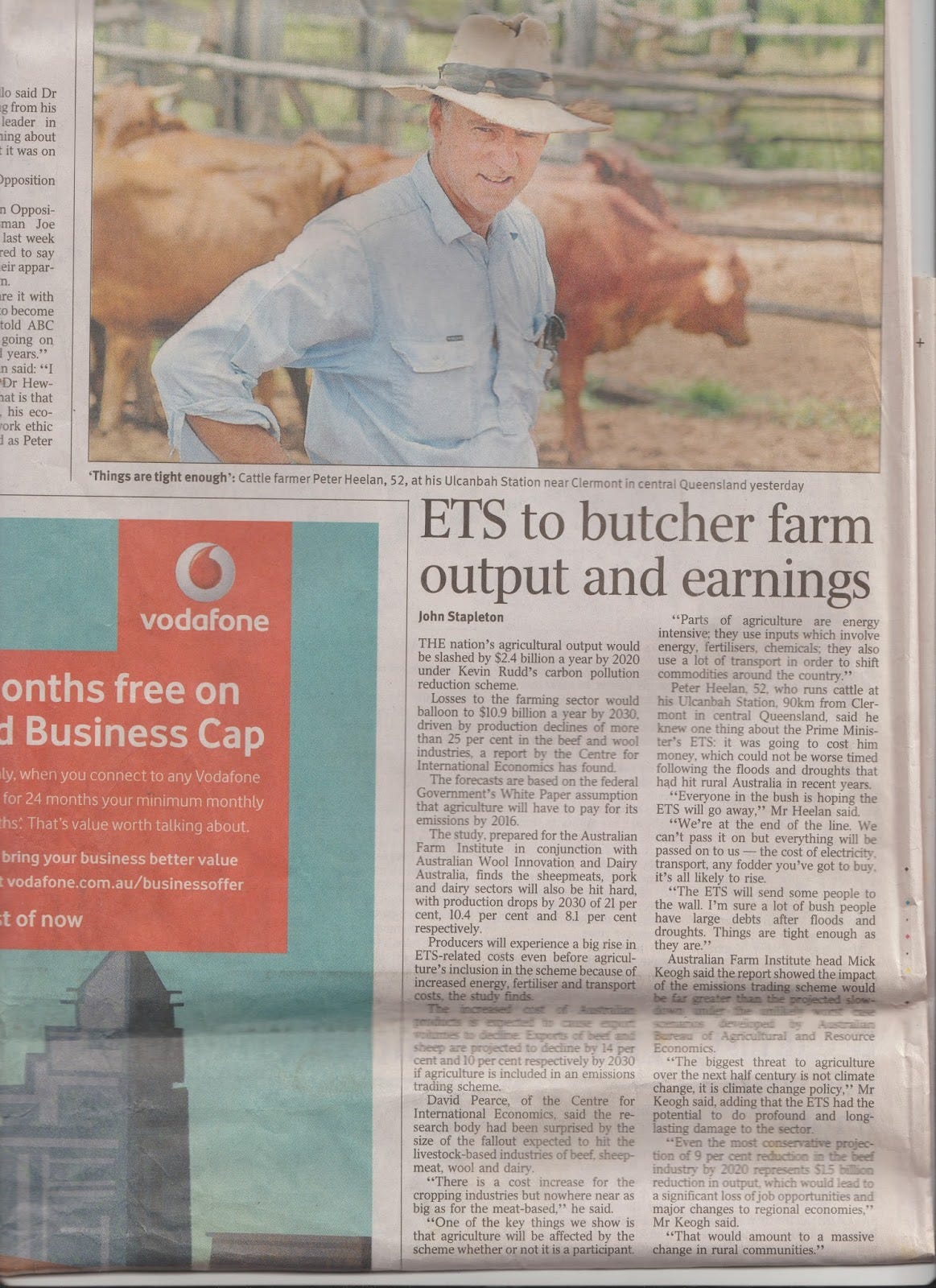ETS to butcher farm output and earnings, The Australian, 23 February, 2009.

ETS to butcher farm output and earnings
Stapleton, John. The Australian [Canberra, A.C.T] 23 Feb 2009: 4.
Abstract
"We're at the end of the line. We can't pass it on but everything will be passed on to us -- the cost of electricity, transport, any fodder you've got to buy, it's all likely to rise.
"The ETS will send some people to the wall. I'm sure a lot of bush people have large debts after floods and droughts. Things are tight enough as they are."
"The biggest threat to agriculture over the next half century is not climate change, it is climate change policy," Mr [Mick Keogh] said, adding that the ETS had the potential to do profound and long-lasting damage to the sector.
Full Text
THE nation's agricultural output would be slashed by $2.4 billion a year by 2020 under Kevin Rudd's carbon pollution reduction scheme.
Losses to the farming sector would balloon to $10.9 billion a year by 2030, driven by production declines of more than 25 per cent in the beef and wool industries, a report by the Centre for International Economics has found.
The forecasts are based on the federal Government's White Paper assumption that agriculture will have to pay for its emissions by 2016.
The study, prepared for the Australian Farm Institute in conjunction with Australian Wool Innovation and Dairy Australia, finds the sheepmeats, pork and dairy sectors will also be hit hard, with production drops by 2030 of 21 per cent, 10.4 per cent and 8.1 per cent respectively.
Producers will experience a big rise in ETS-related costs even before agriculture's inclusion in the scheme because of increased energy, fertiliser and transport costs, the study finds.
The increased cost of Australian products is expected to cause export volumes to decline. Exports of beef and sheep are projected to decline by 14 per cent and 10 per cent respectively by 2030 if agriculture is included in an emissions trading scheme.
David Pearce, of the Centre for International Economics, said the research body had been surprised by the size of the fallout expected to hit the livestock-based industries of beef, sheepmeat, wool and dairy.
"There is a cost increase for the cropping industries but nowhere near as big as for the meat-based," he said.
"One of the key things we show is that agriculture will be affected by the scheme whether or not it is a participant.
"Parts of agriculture are energy intensive; they use inputs which involve energy, fertilisers, chemicals; they also use a lot of transport in order to shift commodities around the country."
Peter Heelan, 52, who runs cattle at his Ulcanbah Station, 90km from Clermont in central Queensland, said he knew one thing about the Prime Minister's ETS: it was going to cost him money, which could not be worse timed following the floods and droughts that had hit rural Australia in recent years.
"Everyone in the bush is hoping the ETS will go away," Mr Heelan said.
"We're at the end of the line. We can't pass it on but everything will be passed on to us -- the cost of electricity, transport, any fodder you've got to buy, it's all likely to rise.
"The ETS will send some people to the wall. I'm sure a lot of bush people have large debts after floods and droughts. Things are tight enough as they are."
Australian Farm Institute head Mick Keogh said the report showed the impact of the emissions trading scheme would be far greater than the projected slowdown under the unlikely worst case scenarios developed by Australian Bureau of Agricultural and Resource Economics.
"The biggest threat to agriculture over the next half century is not climate change, it is climate change policy," Mr Keogh said, adding that the ETS had the potential to do profound and long-lasting damage to the sector.
"Even the most conservative projection of 9 per cent reduction in the beef industry by 2020 represents $1.5 billion reduction in output, which would lead to a significant loss of job opportunities and major changes to regional economies," Mr Keogh said.
"That would amount to a massive change in rural communities."
Credit: John Stapleton



